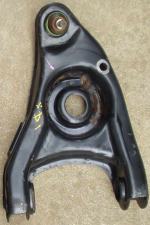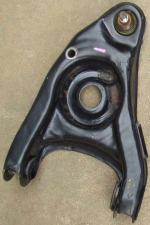

Date: May 15th, 2005
I can drive a car with a lot of roll, but the struts and shocks in the 86 Mustang were done. They were so worn out that the car was bouncing around over the smallest bumps and making for some exciting zero-G experiences in right to left transitions. The rear shocks had ~200,000 miles on them, the front struts were some junkyard bits from the 1990 donor Mustang used for the 87-93 spindle/Lincoln 73mm SS piston caliper upgrade. I had not realized that I was supposed to also grab the longer 89-93 tie rod ends at the time, so I needed to rectify that problem too. All of this made for the logical conclusion that it was time to change out the entire front suspension.
I had been putting these changes off for some time because I was passing plenty of Mustangs with modified suspensions on the track. I'd read many posts on the lists that described various handling issues associated with upgrades to one part of the car causing the other parts to misbehave. I would rather spend my time driving than tweaking so I have avoided such issues up until now. After much research, I decided to go ahead and make the change to an SN-95 front suspension. I obtained parts from a 1998 V6 Mustang, a 1994 Mustang GT, and 1998 Mustang Cobra to complete the package.
This was a great upgrade to the car's suspension. Turn 2 at Thunderhill is now a fourth gear turn for me and I can take it from the midpoint to exit at full throttle. I have better turn-in, less negative camber loss, and more grip. One thing to note is that the 1986 factory K-member is about an inch narrower at the lower control arm (LCA) mount points than the later cars. This turns out to be a good thing, because the longer SN-95 LCAs push the wheel out 1-3/4" on each side and forward slightly (4mm?). So my net gain in front track was about 3/4" which turns out to equal the rear track gain I had from the 1988 Lincoln LSC rear disc brake upgrade I did a few years earlier. My experience is that I had very little additional tire rubbing with this combination. If you do get some tire rub in the front, use steering stops to avoid damage from the rubbing.
If you are modifying a 1990-1993 Fox Platform car, you will want to contiinue to use your same Fox struts because the popular opinion is that they have an inch more bump travel. If you have a 1985-1988? Mustang, then you will want the 1989 and later struts.
| Date | Photo | Notes |
|---|---|---|
| May 2005 |
|
The 1998 Mustang LCAs as they came from the junkyard. Well, not quite as they came; they are on fire! This is the part of the project that is the least fun. It takes awhile, smells alot, and is potentially dangerous. |
| May 2005 |
|
Use a torch to light the rubber on fire and to warm up the LCAs. Don't go anywhere near the ball joint and don't heat the LCA excessively. You only need to get the rubber warm enough so that the rubber will continue to burn. Once the rubber has burned for a bit, it will be possible to push out the old bushing. The inner bushing shell is made of metal and will also come out. The inner shells can be trashed. The outer shell needs to be pressed out using a socket or punch. I don't know why a press can't be used to take the bushings out, but I've read that burning them is the common way to do this. |
| May 2005 |
|
Ding! They're done. |
| May 2005 |


|
Once the old bushings have come out and the arms have had a bath, they should look like this. Those two end link holes will not be used and two new holes of similar or slightly smaller size will need to be drilled. |
| May 2005 |
|
The new urethane bushings with some urethane spring isolators underneath. FWIW, the spring isolators are not strictly necessary, but they do cut down on the noise that the spring makes. |
| May 2005 |
|
Bushing size. When I received my Prothane urethane bushings from Maximum Motorsports, they were the wrong size. No one had mentioned that they came in two different sizes. At any rate, this photo shows the size difference between the 2" LCA hole and the considerably smaller bushing. I believe that this means that I have LCAs designed for the "Hydro" bushing. |
| May 2005 |
|
The 1994 SN-95 spindles with single piston calipers and rotors. I originally bought this whole assembly, but the brake system only stayed on the car for about a week. At that point, I noticed the Cobra setup on the rear of the 88 LX in the garage and canabalized them for the track event the next day. 13" Cobra rotors mean that you will need to have 17" wheels up front. |